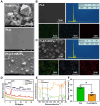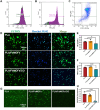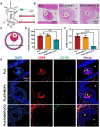FeMOFs/CO loading reduces NETosis and macrophage inflammatory response in PLA based cardiovascular stent materials
- PMID: 39776860
- PMCID: PMC11703552
- DOI: 10.1093/rb/rbae140
FeMOFs/CO loading reduces NETosis and macrophage inflammatory response in PLA based cardiovascular stent materials
Abstract
Modification of polylactic acid (PLA) is a promising strategy for the next generation of bioresorbable vascular stent biomaterials. With this focus, FeMOFs nanoparticles was incorporated in PLA, and then post loading of carbon monoxide (CO) was performed by pressurization. It showed FeMOFs incorporation increased hydrophilicity of the surface and CO loading, and CO release was sustained at least for 3 days. It is well acknowledged NETosis and macrophage mediated inflammation are the principal effectors of atherosclerosis and cardiovascular disease, and it further increases the risk of late stent thrombosis and restenosis. In this study, the effects of CO release of PLA/FeMOFs/CO on NETosis and macrophage behavior were thoroughly explored. In vitro evaluation results showed that PLA/FeMOFs/CO significantly inhibited neutrophil extracellular traps (NETs) release and neutrophil elastase expression by reducing intracellular reactive oxygen species in a simulated inflammatory environment. It reduced Lipopolysaccharide-induced macrophage inflammation with decreased tumor necrosis factor-α expression and increased IL-10 expression. Meanwhile it enhanced endothelial cell activity and growth in inflammatory environment, and inhibited platelet adhesion and activation. In vivo implantation results confirmed that PLA/FeMOFs/CO reduced the macrophages and neutrophils mediated inflammatory response, thus reduced the neointimal hyperplasia. Overall, PLA/FeMOFs/CO effectively prevented the inflammation and restenosis associated with PLA implantation. Our study provides a new strategy to improve the immunocompatibility of PLA implant materials.
Keywords: FeMOFs; NETosis; carbon monoxide; inflammation; macrophage.
© The Author(s) 2024. Published by Oxford University Press.
Figures










Similar articles
-
Carbon monoxide-releasing Vehicle CO@TPyP-FeMOFs modulating macrophages phenotype in inflammatory wound healing.Nitric Oxide. 2024 Aug 1;149:49-59. doi: 10.1016/j.niox.2024.06.005. Epub 2024 Jun 17. Nitric Oxide. 2024. PMID: 38889652
-
Hydrophilic titanium surfaces reduce neutrophil inflammatory response and NETosis.Biomater Sci. 2020 Apr 21;8(8):2289-2299. doi: 10.1039/c9bm01474h. Epub 2020 Mar 12. Biomater Sci. 2020. PMID: 32163073
-
Activated protein C inhibits neutrophil extracellular trap formation in vitro and activation in vivo.J Biol Chem. 2017 May 26;292(21):8616-8629. doi: 10.1074/jbc.M116.768309. Epub 2017 Apr 13. J Biol Chem. 2017. PMID: 28408624 Free PMC article.
-
Intercellular Interactions as Regulators of NETosis.Front Immunol. 2016 Nov 14;7:453. doi: 10.3389/fimmu.2016.00453. eCollection 2016. Front Immunol. 2016. PMID: 27895638 Free PMC article. Review.
-
An exploratory look at NETosis in atherosclerosis.Intern Emerg Med. 2017 Feb;12(1):13-22. doi: 10.1007/s11739-016-1543-2. Epub 2016 Sep 21. Intern Emerg Med. 2017. PMID: 27655025 Review.
Cited by
-
Biomimetic Design and Assessment via Microenvironmental Testing: From Food Packaging Biomaterials to Implantable Medical Devices.Biomimetics (Basel). 2025 Jun 5;10(6):370. doi: 10.3390/biomimetics10060370. Biomimetics (Basel). 2025. PMID: 40558339 Free PMC article. Review.
References
-
- Tsao CW, Aday AW, Almarzooq ZI, Alonso A, Beaton AZ, Bittencourt MS, Boehme AK, Buxton AE, Carson AP, Commodore-Mensah Y, Elkind MSV, Evenson KR, Eze-Nliam C, Ferguson JF, Generoso G, Ho JE, Kalani R, Khan SS, Kissela BM, Knutson KL, Levine DA, Lewis TT, Liu J, Loop MS, Ma J, Mussolino ME, Navaneethan SD, Perak AM, Poudel R, Rezk-Hanna M, Roth GA, Schroeder EB, Shah SH, Thacker EL, VanWagner LB, Virani SS, Voecks JH, Wang N-Y, Yaffe K, Martin SS. Heart disease and stroke statistics—2022 update: a report from the American Heart Association. Circulation 2022;145:e153–e639. - PubMed
-
- Schapiro-Dufour E, Tricotel A, Slama MS, Ducimetière P, Trinh-Duc A, Sichel C, Le Tri T, Galmiche H, Dray-Spira R, Zureik M. Major ischaemic and bleeding risks following current drug-eluting stent implantation: are there differences across current drug-eluting stent types in real life? Arch Cardiovasc Dis 2019;112:469–84. - PubMed
-
- Dworeck C, Angeras O, Haraldsson I, Ioanes D, Odenstedt J, Petursson P, Robertsson L, Stewart J, Volz S, Albertsson P, Råmunddal T, Omerovic E. TCT-477 long-term risk of stent thrombosis and restenosis after treatment with drug-eluting stents: a report from SCAAR. J Am Coll Cardiol 2016;68:B191–2.
-
- Lasprilla AJR, Martinez GAR, Lunelli BH, Jardini AL, Filho RM. Poly-lactic acid synthesis for application in biomedical devices–a review. Biotechnol Adv 2012;30:321–8. - PubMed
LinkOut - more resources
Full Text Sources

